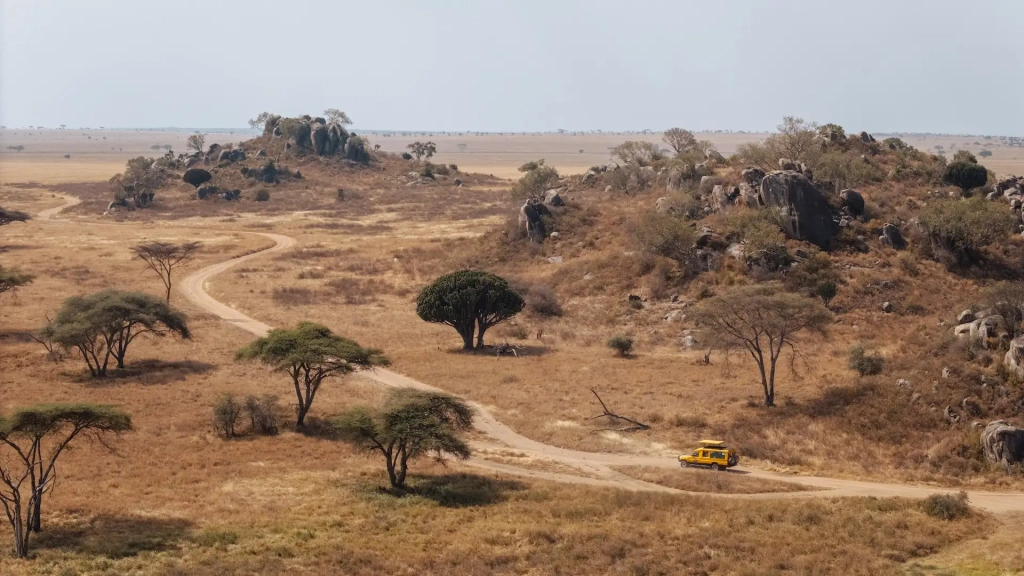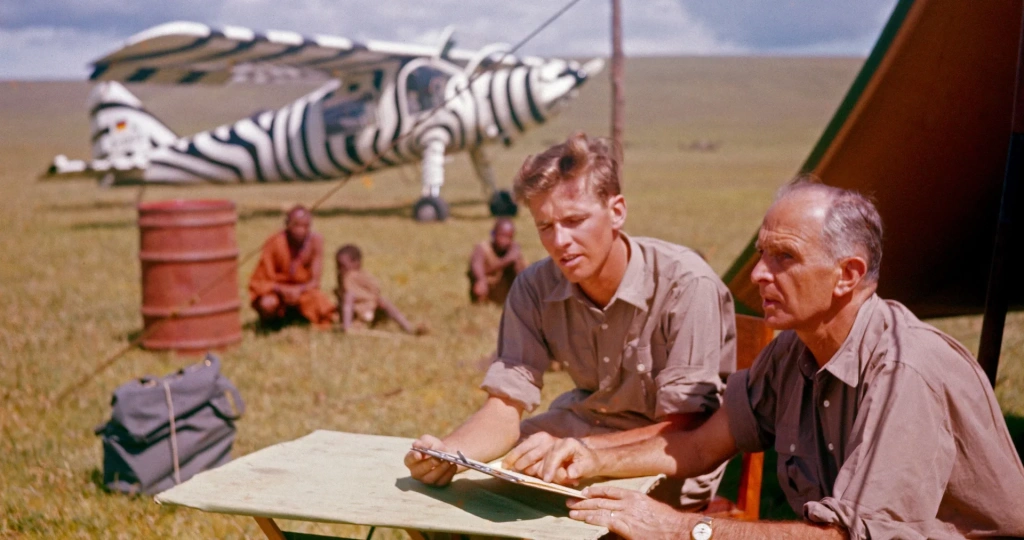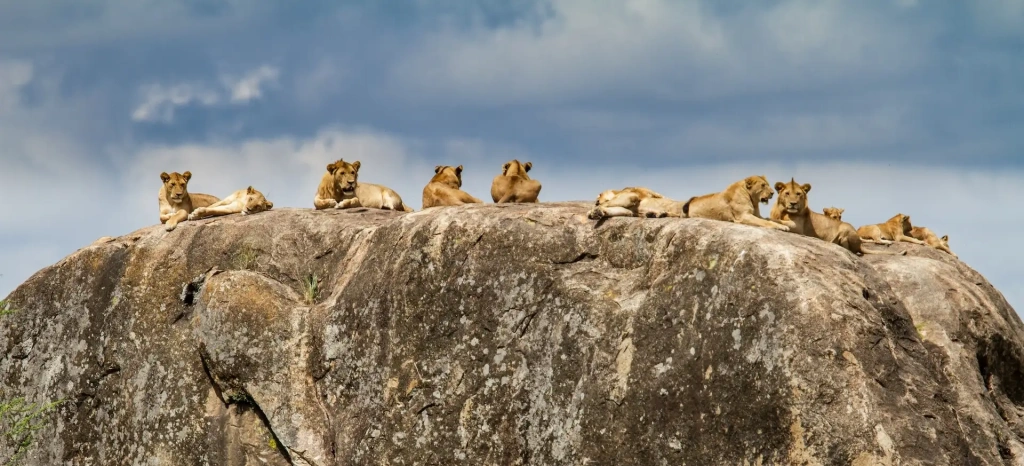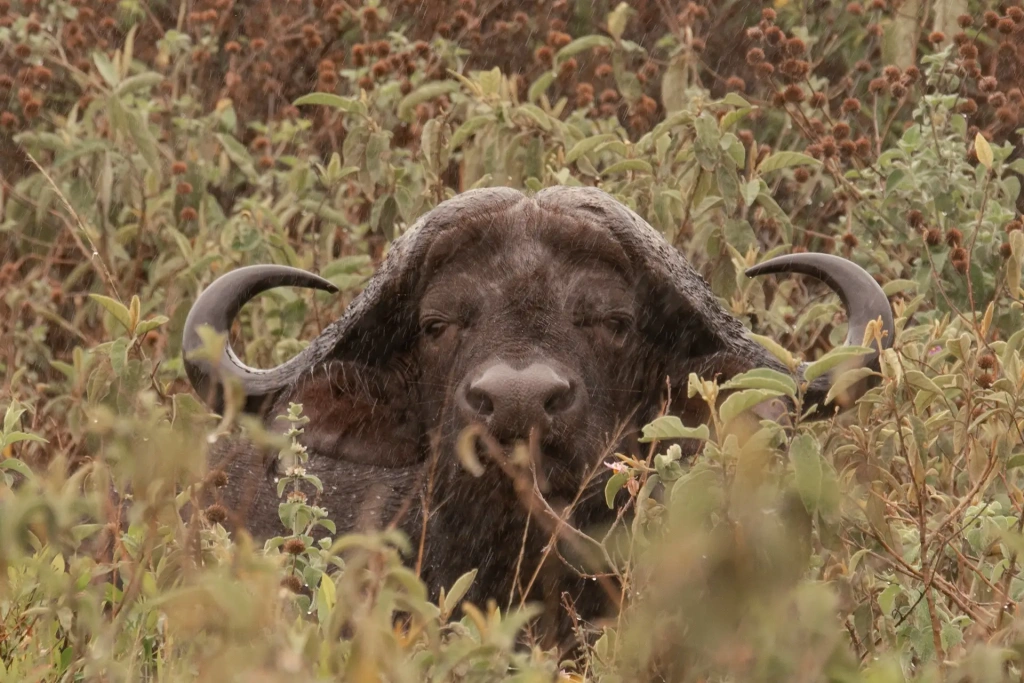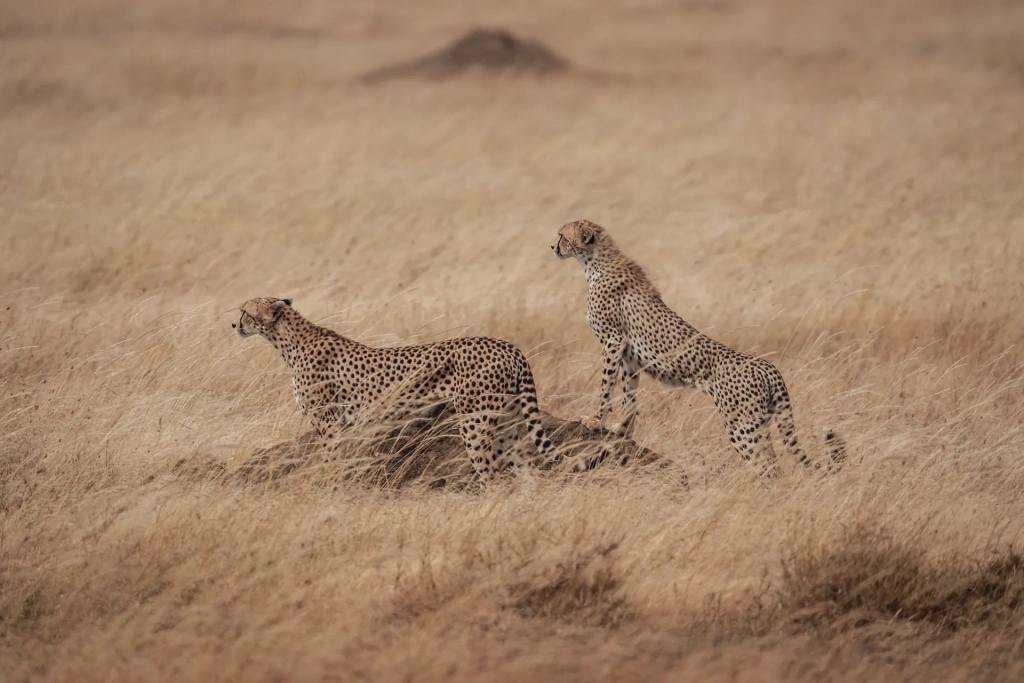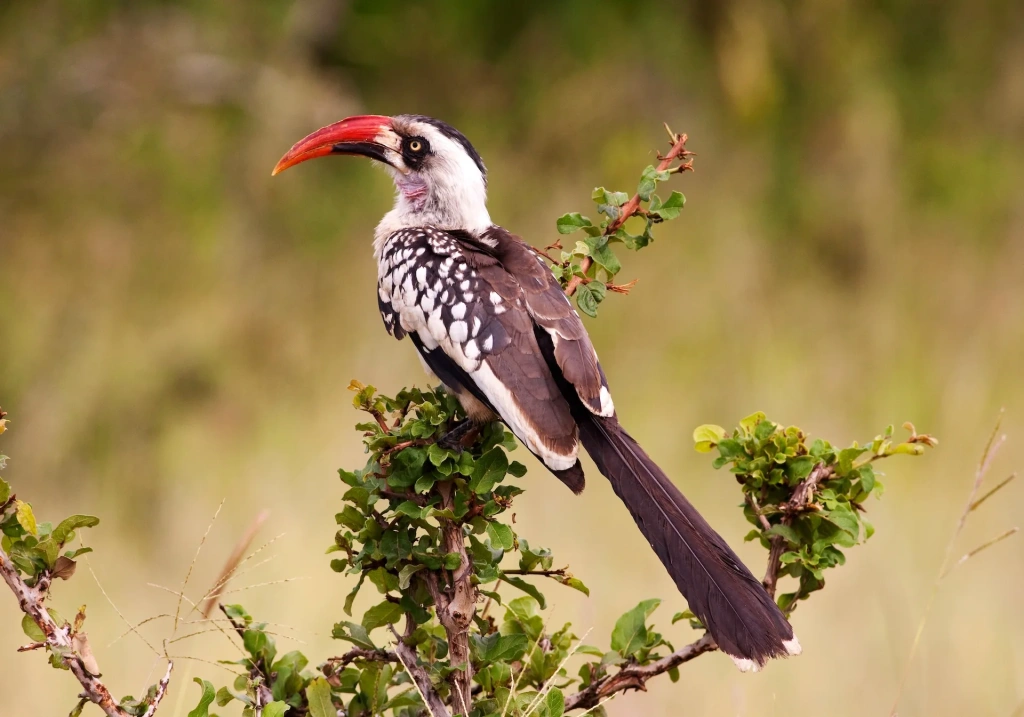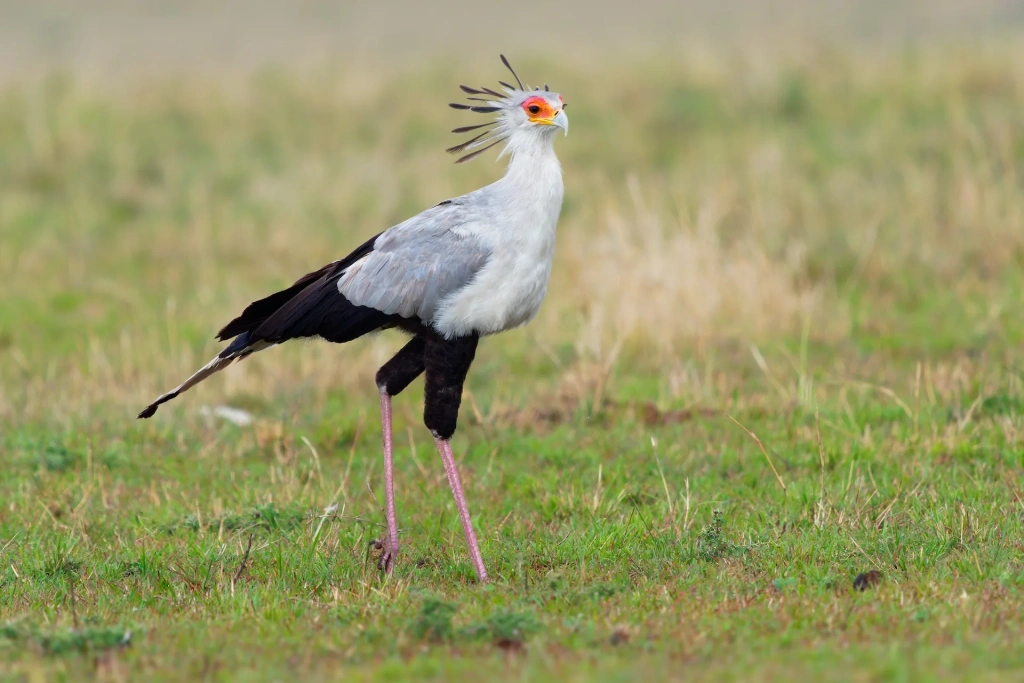The Serengeti National Park is a true paradise for nature lovers. It offers everything travelers hope to encounter on an African safari: classic savanna landscapes, lions resting on rocks, herds of elephants, the migration of countless antelopes, predator hunting scenes, rivers teeming with crocodiles and hippos, and hundreds of species of tropical birds. This guide highlights the animals you will most likely see in Serengeti National Park.
Serengeti safari animals
The Serengeti is home to millions of hoofed animals and thousands of predators. While no one knows the exact numbers, the national park’s plains are believed to host Africa's largest herds of antelopes, zebras, and buffalo. The Serengeti ecosystem is also thought to have the highest concentration of predators, including hyenas, lions, and cheetahs.
On a safari here, you’ll have the chance to see the most iconic Serengeti animals: lions, leopards, elephants, giraffes, buffalo, rhinos, a wide variety of antelope species, cheetahs, hippos, zebras, mongooses, baboons, hyenas, jackals, warthogs, and more.
As for birds, you can easily spot hornbills, marabou storks, francolins, ibises, secretarybirds, ostriches, and many others. In fact, birders have recorded over 600 species in the Serengeti!
Safari in Serengeti

Between 2,000 and 3,000 animal species live in the Serengeti. Most of these are small invertebrates, but the ecosystem also includes around 100 species of reptiles, amphibians, and fish, over 70 species of mammals, and, as mentioned earlier, several hundred species of birds.
Why is the Serengeti so rich in species? There are several key reasons:
- Landscape diversity. The range from fertile southern plains to northern hills, rivers, and remnants of ancient lowland forests creates ideal conditions for different ecological niches.
- Climatic cycles. Rains, droughts, and natural fires constantly refresh the grassland pastures, drawing in a wide range of herbivores and, in turn, the predators that follow them.
- The Great Migration. The ongoing movement of wildebeests, gazelles, and zebras promotes genetic diversity among populations and helps sustain food chain connections across different parts of the ecosystem.
The Great Wildebeest Migration
The Great Wildebeest Migration in the Serengeti is one of nature’s true wonders. This phenomenon was first documented and extensively studied in the 1950s, largely thanks to German zoologist Bernhard Grzimek.
The authorities planned to change the national park's boundaries at that time. During his field research, Grzimek discovered that proposed changes would disrupt the natural migration routes of wildebeests, zebras, and other animals, posing a serious threat to the entire ecosystem. He meticulously tracked the animals’ movements and convinced the government to protect these vital migration corridors.
Grzimek’s words, “Serengeti shall not die,” became the title of his book and the motto of the national park. Visitors can read these words on a stone monument at the park’s entrance. The Great Wildebeest Migration led to the creation of Serengeti National Park as we know it today.
Thanks to the Great Migration, the Serengeti was designated a UNESCO World Heritage Site in 1981. In 2013, the phenomenon was included in the list of the seven natural wonders of Africa.
Discover when and where the Great Migration happens, and learn the best time to visit the Serengeti to witness this incredible natural event.
Africa’s Big Five
The Big Five refers to five large animals that were considered the most dangerous during the era of safari hunting. Hunters called them the hardest to track as they could kill or seriously injure their pursuers when cornered and wounded. Since then, the term Big Five has remained popular among safari enthusiasts. Today, it means a group of animals one must see on an African safari.
Lions in the Serengeti
About 3,000 lions roam the Serengeti, most found in the Seronera Valley and around the Simba, Gol, and Moru . Some researchers believe these areas are home to the largest lion populations in Africa. The huge herds of prey, with millions of hoofed herbivores, draw them in. The Serengeti has many lion prides, some quite large, with up to 30 members. You might come across two or three of these big prides on a single trip across the plains.
Elephants in the Serengeti
Elephants prefer spending time in forested areas, but that doesn’t mean they’re hard to spot. Herds of females with calves often come into view during safaris. Male elephants usually travel alone or form bachelor groups. Back in the 1980s, researchers estimated there were only about 2,000 elephants in the Serengeti. Today, their numbers have grown to at least 8,000, possibly nearing 10,000.
African buffaloes in the Serengeti
Buffaloes might seem peaceful and completely harmless, grazing without a care in the world. But don’t be fooled: a buffalo can be very dangerous, especially if it senses a threat to its calves. These animals don’t roam alone, but gather in herds, often numbering in the hundreds. In the Serengeti, it’s not uncommon to see massive herds of up to a thousand buffalo. In total, around 50,000 buffalo call the Serengeti home.
Leopards in the Serengeti
Though active during the day, leopards are very secretive animals, making it hard to estimate their population. Several hundred to a thousand leopards are believed to live in the Serengeti. They’re not easy to spot, so when a safari guide announces a leopard sighting, everyone rushes to that location. It’s common to see a leopard resting in a tree, often with one or two antelope carcasses it has hoisted up to keep away from scavengers. This strong and agile predator hoists its prey into the trees to protect it from lions and hyenas.
Rhinos in the Serengeti
Another rare member of the Big Five is the rhinoceros. In the past, tens of thousands of rhinos roamed the African plains, but poaching has drastically reduced their numbers. Poachers kill these animals for their horns, which can sell for prices as high as or even higher than gold. Today, the rhinoceros is considered an endangered species, with only about 10,000 white rhinos and around 3,000 black rhinos left across the continent. In many national parks, including the Serengeti, no wild populations remain. However, a rhino reserve operates in Moru Kopjes, where the exact number of animals is not disclosed. Travelers can visit the reserve and observe the rhinos there.
What other animals can you see in the Serengeti?
In addition to the Big Five, the Serengeti is home to a vast array of other wildlife. The most numerous are wildebeests, with a population of no less than 1.6 million. Other abundant antelope species include 300,000 Thomson’s gazelles and tens of thousands of Grant’s gazelles, impalas, topis, kongonis, elands, duikers, and dik-diks. Among the rarer species are the striking roan antelopes and nimble klipspringers.
Besides antelopes, at least 200,000 zebras and over a thousand giraffes roam the Serengeti plains. Giraffes are most commonly seen near the Gol Mountains and in the forests of Ndutu. Waterbucks can often be spotted near rivers, favoring flooded meadows and valleys.
Among the predators in the Serengeti, hyenas are the most numerous, with around 7,500 individuals. Lions come next, with at least 3,000 across the region, followed by cheetahs, whose population is much smaller, barely 500. Cheetahs are most commonly found in the southeastern areas of the national park.
Other Serengeti predators include jackals, servals, bat-eared foxes, wildcats, mongooses, and the relatively rare African wild dogs. At night, African civets, aardvarks, and aardwolves, also known as earth hyenas, emerge to hunt. Catching a glimpse of the Serengeti’s nocturnal wildlife is a rare and fortunate experience.
Other elusive yet fascinating residents of the Serengeti include porcupines, pangolins, and the famously tough but rarely seen honey badger. In contrast, warthogs, baboons, and vervet monkeys can often be seen in various parts of the park. Some animals even venture into picnic areas and other crowded spots, making sightings quite common. Among the boldest are small primates and rock hyraxes, little creatures that resemble oversized guinea pigs.
Hippos are a constant presence in the rivers of the Serengeti and surrounding areas. The park is home to around 2,000 of these massive animals, and spotting them on safari is usually effortless. Even when only their heads and backs are visible above the water, watching a group of hippos is always fascinating. Sharing the rivers with them are Nile crocodiles. Researchers estimate their population in the hundreds, and they’re just as easy to find: crocodiles often lie motionless for hours in shallow water, barely changing their position.
With a bit of luck, you might catch a glimpse of some of Tanzania’s snakes, the largest of which are pythons. The Serengeti is also home to other reptiles, including turtles, monitor lizards, and various lizards. Among them are chameleons, which often draw special interest from visitors.
Birdwatching in Serengeti
The Serengeti hosts several bird species that are particularly interesting to birdwatchers and endemic to Tanzania. Notable examples include the Grey-breasted Spurfowl (Pternistis rufopictus), Tanzanian Red-billed Hornbill (Tockus ruahae), White-tailed Cisticola (Cisticola anderseni), and Rufous-tailed Weaver (Histurgops ruficauda). There are also semi-endemic species, occasionally seen near neighboring countries' borders. These birds are especially prized by birders with limited time, as they may not be able to visit multiple parks to find rarer species. In the Serengeti, however, those chances are significantly higher.
Among the recognizable African birds living in the Serengeti are:
- Abdim's Stork, the smallest of all storks;
- African Darter, which gets its name from its unique fishing method: darting its long neck underwater to spear fish;
- secretive African Gray Hornbill;
- African Fish-Eagle, known for its piercing calls;
- African Harrier-Hawk, famous for stealing eggs from weaver bird nests;
- African Openbill, which is easy to find near hippos;
- Vulturine Guineafowl, featuring luxurious glossy plumage;
- Superb Starling, whose name speaks for itself;
- Southern Ground-Hornbill, the only predator among all hornbills;
- Secretarybird, a tireless snake hunter featured in the Oscar-winning animated film “Flow,”;
- Common Ostrich, the largest bird on the planet;
- Marabou Stork, a scavenger bird and the largest of all storks;
- Lilac-breasted Roller, one of the most colorful birds of East Africa;
- Hadada Ibis, known for the metallic sheen on its greenish wings and its distinctive call, which gave the bird its name;
- Hamerkop, which builds impressive nests 1.5 meters (5 feet) in diameter and often decorates them with bones to distract attention from the entrance.
The Serengeti is teeming with fascinating birdlife. The great news for birdwatchers is that birding here is rewarding year-round. However, the prime season runs from November to April, when local species are in their breeding plumage and numerous migratory birds arrive from North Africa and Europe. For a deeper look at the region’s avian diversity, check out our article on the birds of Serengeti National Park and nearby areas in northern Tanzania.
When planning your safari, consider making a personal list of the Serengeti animals you’d most like to see. Feel free to contact us: we’ll create a safari program tailored to your interests. In the meantime, explore more fascinating facts about the Serengeti, a park renowned not just for its wildlife.
All content on Altezza Travel is created with expert insights and thorough research, in line with our Editorial Policy.
Want to know more about Tanzania adventures?
Get in touch with our team! We've explored all the top destinations across Tanzania. Our Kilimanjaro-based adventure consultants are ready to share tips and help you plan your unforgettable journey.















